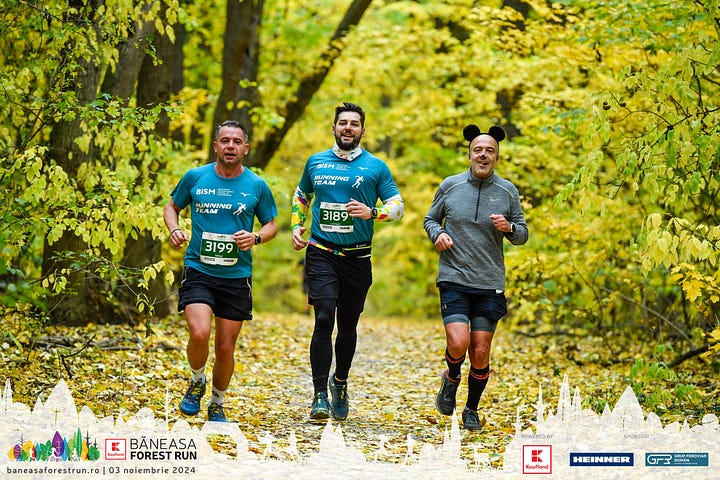👋 Hey, Leo here! Welcome to The Tech Leadership Playbook. Each week, I explain the concepts needed to become a better tech leader and grow your career. Subscribe to get every issue in your inbox.
Hey Friends,
Welcome to the 82nd edition of my newsletter.
Personal Update
Well, last Sunday I completed my 3rd marathon, in the Baneasa Forest.
Unlike the others, I didn’t have a target for finishing it, and just wanted to have fun instead, and I had a lot of fun, running with two of my friends from the running club I’m in.
I talk more about the experience in this LinkedIn post:
We talked the whole way and time flew by.
And I decided I will do my first marathon next year, hopefully in May-Jun.
If you have any suggestions for marathons that happen in that period in Europe, let me know in the comments or reply to this email.
Here are more photos from the experience:




Regarding CrossFit training, it was a very good week, as I power-cleaned 100 kg for the first time. It is a milestone in my weightlifting journey, and I’m amazed to see the results of hard work and consistency.
You can see it on my Instagram.
On the other hand, I got an email from Hyrox saying that the competition in Valencia, which was supposed to happen in two weeks, got postponed to March. This was disappointing, but it makes sense. For those of you who don’t know, the Valencia region was hit by massive floods in the past few weeks.
So, the new dates are in March, and I need to see what I can do with the accommodation and plane tickets.
Oh, I almost forgot about one of my biggest wins from last week:
I got my first paid subscriber last week!
It’s $5 but it means the world to me to see that people appreciate my work and the effort I put into this Newsletter.
At this moment, the only advantage a paid subscriber has is access to the whole library of my newsletters (not only from the last month), but I will add some special gifts and perks soon.
Again, supporting my work means I am doing the right thing and it’s a great incentive to keep going.
Now, let’s talk about a topic that came to my mind this week: do you need a large team?
The Power of Small Teams: Why Less Can Be More in Tech
I've been thinking a lot about team size lately.
In tech, we often fall into the trap of thinking that bigger teams mean better results.
"If we just had more people," the thinking goes, "we could ship faster and build more features."
Ego also plays an important role, as it’s one thing to tell your friends that you lead a team of 10, and it’s another to say you’re responsible for 50 people in the department.
But history tells us a different story.
Actually, some of the most revolutionary products were created by surprisingly small teams.
The Magic of Small Teams
WhatsApp: 35 People, $19 Billion Exit
When Facebook acquired WhatsApp in 2014, people were shocked to learn how small the company was. They had only 35 engineers managing a messaging platform used by 450 million monthly active users.
That's about 13 million users per employee!
The small team size wasn't a limitation; it was a strategic advantage that allowed for quick decisions, minimal bureaucracy, and laser-sharp focus on performance and reliability.
Instagram: 13 People Changed How We Share Photos
When Facebook acquired Instagram for $1 billion in 2012, the photo-sharing app had just 13 employees.
Yes, you read that right—13 people built and scaled a platform that had 30 million users at the time.
They achieved this by ruthlessly focusing on what mattered most: the core photo-sharing experience.
By the way, most analysts thought Zuckerberg was crazy to pay this amount of money for an app that is similar to your core business. But that’s what happens when you don’t understand how business works.
The Original Macintosh: Small Team, Massive Impact
The original Macintosh, which revolutionized personal computing, was developed by a core team of about 20 people.
Steve Jobs famously said, "A small team of A+ players can run circles around a giant team of B and C players."
He deliberately kept the team small to maintain the creative tension and shared vision necessary for breakthrough innovation.
Craigslist: Minimal Team, Maximum Impact
Even today, Craigslist operates with fewer than 50 employees despite being one of the world's most visited websites.
It comes to show that you don't need armies of developers to maintain and scale a platform used by millions.
Why Small Teams Can Outperform Large Ones
After studying these and other examples, I've identified several key advantages of small teams:
1. Communication Efficiency
In small teams, information flows naturally.
There's no need for endless meetings, status reports, or complex documentation.
Everyone knows what everyone else is doing.
2. Quick Decision Making
With fewer stakeholders, decisions can be made rapidly.
No need to align multiple departments or navigate complex approval chains.
This speed becomes a competitive advantage.
3. Shared Vision
It's easier to maintain a clear, shared vision when the team is small.
Everyone understands the mission and their role in achieving it.
There's less room for misalignment or competing priorities.
4. Individual Impact
In a small team, each person's contribution is visible and meaningful.
This creates a powerful sense of ownership and motivation that's hard to replicate in larger organizations.
5. Focus
Small teams are forced to prioritize ruthlessly.
They can't do everything, so they focus on what truly matters.
This constraint often leads to better product decisions.
What This Means for Tech Leaders
If you're leading a tech team or planning to scale one, here are some practical takeaways:
1. Start Small, Stay Small: Before expanding your team, ask yourself if you really need more people. Could you achieve more by helping your current team work more effectively?
2. Build Elite Teams: Focus on hiring exceptional people, A+, as Jobs would put it, who can handle multiple responsibilities. One great engineer can often do the work of several average ones, and I’ve seen this in practice, several times.
3. Embrace Constraints: Limited resources can force creativity and innovation. Don't see a small team as a limitation, but as an opportunity to focus on what really matters.
4. Automate Aggressively: Small teams can achieve scale through smart automation. Invest in tools and processes that multiply your team's impact.
5. Maintain Direct Communication: As your team grows, try to preserve the direct communication and quick decision-making that make small teams effective.
Final Thoughts
First of all, this only works in teams that develop products or fix-price services.
If your goal is to outsource your people, like in a time-and-material manner, than you want to have as many people available for your customer as possible.
But, if you work in product, the next time someone tells you they need a bigger team to achieve ambitious goals, remember WhatsApp's 35 engineers or Instagram's team of 13.
The size of your team matters far less than:
The clarity of your vision
The quality of your people
The focus of your execution
The effectiveness of your processes
Sometimes, the best way to do more is to work with less.
Your Turn
What's your experience with team sizes?
Have you found that bigger teams always lead to better results?
Let me know in the comments section!
Recommendations:
Last week I finished No Rules Rules: Netflix and the Culture of Reinvention. It’s an amazing read (or listen, as I had) about the culture of the tech giant. I will talk about it in more detail in the next few weeks. Spoiler alert: it’s not the type of culture any company can adopt.
I showed you last week this photo I took when I visited my mom last week. I turned it in a LinkedIn post, and it had a lot of success. I talk a bit about my story in it so check it out if you hadn’t already (and don’t forget to Follow me 😉)
This Substack post from Torsten about running better meetings.
Well, I hope you liked this edition.
Thank you for reading, and join me in the comments section for further discussions!
Leo
P.S. If you enjoyed this piece and want to support my writing, please consider sharing it and becoming a paid subscriber.
Thank you so much for being here!
P.P.S. If you want to read my content daily, don’t forget to follow me on LinkedIn.







